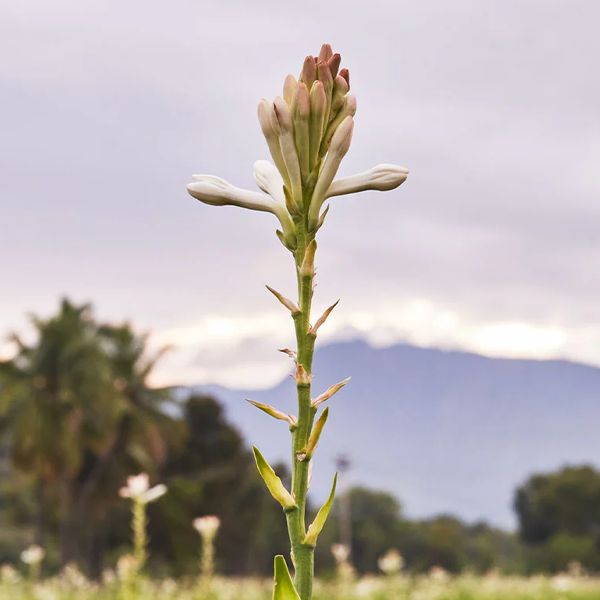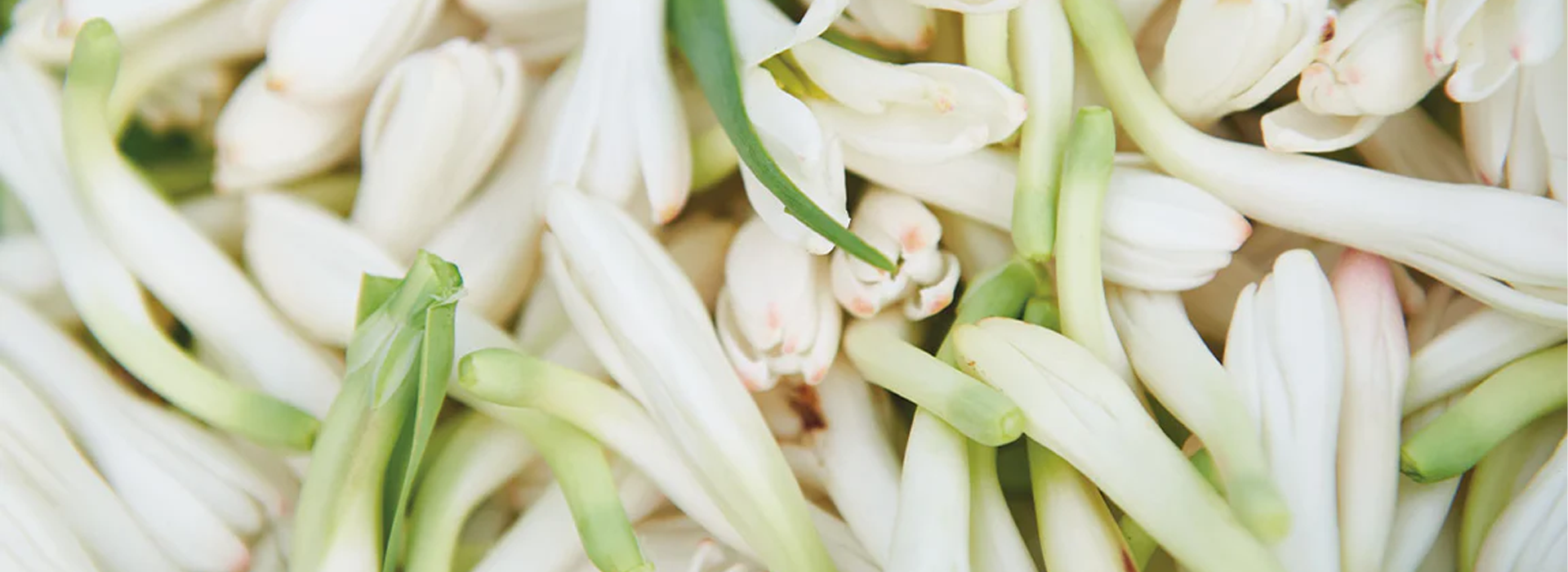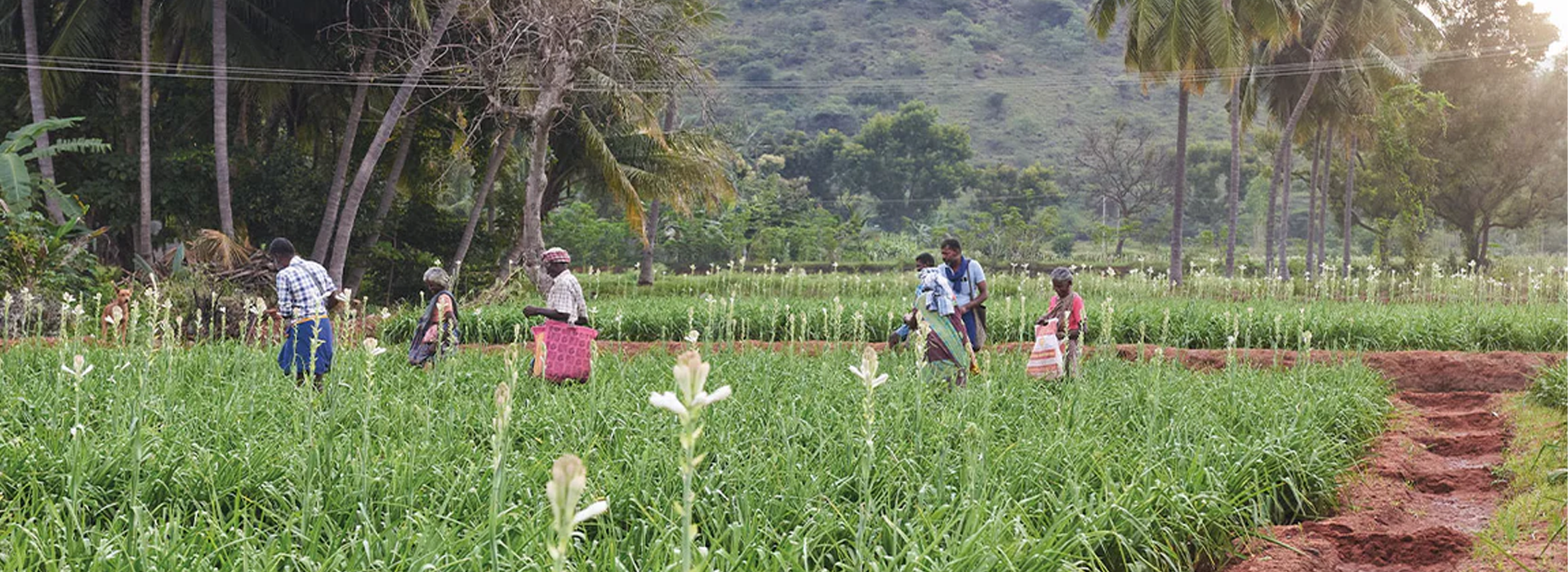
Fragrance Of The Night
7.2.24
Victoria Gaiger visits Madurai, ‘the city that never sleeps’, and, from sunrise to dusk, follows the trail of the tuberose –apreciousflowerfound withina number ofThe House ofCreed’s most beloved perfumes.
At the heart of a few ofThe House of Creed’s fragrances is treasured tuberose, from heavenly Iris Tubéreuse , to graceful Wind Flowers and the newest captivating creation,Queen of Silk. Each fragrance has its own unique composition, and the tuberose is used to varying degrees to enhance and contribute to its distinctive character. Read on as Victoria Gaiger explores this cherished ingredient, from its rich history to its sustainable cultivation practices in India.

An Introduction To Tuberose
They stand to attention like Gormley figures. Long, tall stems against the rich red earth. Clustered spikes of creamy, very fragrant, star-shaped, waxy flowers and buds. The closed buds hold a secret – an aphrodisiac scent so powerful that in India, where the flowers have been grown for centuries, it was once forbidden for women to cross the tuberose fields with their lovers after dark.
Growing tuberose is very labour-intensive, a process that requires constant maintenance, a great deal of weeding and irrigation. The tuberose, Polianthes tuberosa L., is a perennial plant in the Agavaceae family, a lily-type flower grown from a rhizome. There are about 20 snowy-white flowers per spike, and the stems can reach about a metre high. One of the most fragrant plants in the world, its voluptuous flowers have the capacity to emit a rich scent 48 hours after picking.
No wonder it’s a perfumer’s key ingredient, and it is correspondingly expensive – it takes approximately 7 tonnes of tuberose flowers for 1 kilogram of absolute and 1,000 plants to yield an average of 30 to 40 kilograms of flowers. The rhizomes are planted from February to March to flower in July (and as early as March in the second and third years). Harvesting takes place from March to December. After three years, the farmer needs to replace the rhizomes.
The Tuberose Trail
When the city of Madurai, in the south-eastern tip of India, finally sleeps, neon lights flicker and early risers start their commute on motorbikes. We drive through the dark to a field an hour outside of the city and we reach the fields as the sun starts to show through the pink clouds. We watch as the fragile closed buds are picked one by one, carefully but quickly, by a small group of pickers who pass noiselessly from one plant to the next, gathering their harvest.
The damp ferrous earth sticks in clumps to their bare feet as they delicately place the buds in their bags or bunched-up saris – only once they reach their final destination will the corollas start to open, and the waxy flowers release their heady scent. The sun comes up and stray dogs play on the path. The buds are put into sacks and taken to collection points where they will continue on to local flower markets.
In Mattuthavani market, it’s frenetic – there’s colour everywhere; bright orange marigolds, yellow chrysanthemums, cerise roses, sacks of creamy tuberose and white jasmine. Smells of sweet marjoram herb jostle with the potent scents of the flowers. Garlands are being made for the temples with deft fingers. Feet slip on wet discarded flowers, and in the noisy Madurai marketplace piles of collected buds are poured onto the tiled floor. Men are yelling as the buds are gathered up and put into bags, weighed on iron scales, rates are called out and money exchanged. Elbows bump, agents keep track of buying and selling in notebooks and punters carry their bags of flowers home.
Tuberose is sold as an ornamental flower for garland-making, worship and decoration. Prices vary according to supply and demand, sometimes costing as much as €10 per kilo at the height of the wedding season in India. Tuberose destined for the fragrance industry is bought at the end of the day, when its price is at its lowest, and only during the peak production periods of April to June and September to December. Women in colourful saris pick up the blooms checking for quality, holding bags of brightly packed flower heads and walk about with flowers woven in their hair.
We are warned we must not put the flowers we’ve been given or held to our noses back into the pile because the flowers must be untainted for the gods in the temples. I clutch on to my handful of tuberose buds, holding them close to me and breathe in the scent.

A Treasured Scent
The buds have a faint green waxy smell but the flowers once open are ambrosial. The scent of tuberose is rich, hypnotic, narcotic, deep and nuanced: there are velvety, creamy accents; fruity coconut notes; floral notes of orange blossom and jasmine; a honeyed, almost rich warm gardenia note; a balsamic note; a green, medicinal-like quality; and then there’s also the erotic animalic indole tones – sweet, earthy, sensual and carnal.
Despite its big personality, tuberose is versatile: often used to add depth and complexity, sometimes in amber, woody and floral compositions, it is utilised in a delicate manner. It has extraordinary longevity and a great sillage. Its intense scent can be attributed to its complex composition of aromatic compounds. Tuberose naturally contains a high concentration of volatile organic compounds, such as benzyl acetate, methyl benzoate and various floral aldehydes, contributing to the strong and distinctive fragrance.
To capture the fragrance at its best, ‘tuberose must be processed as soon as it blooms’, explains Sambit Misra from Jasmine Concrete Exports Ltd, one of the biggest Indian suppliers to the fine fragrance industry. ‘As soon as the flower opens, it will start losing its scent – the chemical reaction that makes the flower smell the way it does when it blooms is the same one that makes the flower smell bad when it turns, so we have to be quick. The scent is dependent on all sorts of environmental factors – the amount of sun, water and even the particular month the flower is picked.’
Like most white flowers, tuberose is damaged in heat-based extraction. In the past, enfleurage was used as a method to extract perfume from the flower, but today, that extraction process has been replaced with using solvents to produce a ‘concrete’ (a dark caramel-coloured mass that solidifies at room temperature). This concrete can then be treated with ethanol to create the ‘absolute’. The factory at Dindigul houses an industrial processing unit, with laboratories, polished metal containers, where cranes and pulleys, and distillers and coolers make batches of ‘concrete’ and ‘absolute’ ready for the perfume industry.
The History Of Tuberose
Historians believe that the tuberose originated from Central America in Mexico, where the Aztecs used its essential oil to intensify the flavour of their chocolate and utilised the flowers in their religious rituals – Aztecs knew it as Omixochitlor ‘bone flower’.
By the 16th century, it had reached Europe with the Spanish conquest of Mexico. In France, Louis XIV, had more than 10,000 bulbs brought back to his perfumer’s garden at the Trianon and perfumed Versailles with the heady, exotic blooms. In the 17th century, tuberose was cultivated in Grasse, Provence, Languedoc and Liguria, and mainly used to scent gloves. It continued to travel, reaching the East Indies, but it was only after the late-1940s that the cultivation of tuberose moved to the warmer, drier climates such as Morocco, Tunisia, Algeria, the Comoros islands, and Egypt. Tuberose production really took off in the Indian states Tamil Nadu and Karnataka, and by the 1980s, India had become the biggest producer in the world.
Only about 10 per cent of the Madurai tuberose flowers are destined for the perfume industry, the rest are used in religious ceremonies and day-to-day living. Madurai is known for its association with tuberose; both the ‘Rajnigandha’ tuberose and the ‘Madurai Malli’ jasmine play a significant cultural as well as aromatic role in the ‘temple’ city. Tuberose is deeply embedded in the cultural fabric of Madurai, intrinsically woven into the most intimate moments of Indian life.

Sustainable Tuberose Cultivation
Sambit Misra explains how he encourages a sustainable farming model for the farmers they work with. Farmers are offered an alternative approach to floral production, one that improves farmers’ profits as well as the quality of the flowers, and one that leverages permaculture principles such as soil restoration and water supply management to establish a model that will be sustainable for future generations.
Eventually floral quality will improve thanks to a clean and short supply chain, richer organic cultivation, contamination-free farmlands and unprecedented care for each season’s harvest. There is also a commitment to improving the social and economic wellbeing of the farming communities with a fixed price and reduced production costs – to uplift local communities. This builds market security, delivers fixed revenue and fosters a real sense of pride for farming families, securing local families’ livelihoods for now and for future generations.
Tuberose farming faces challenges related to climate variability, drought, pest and disease management, market fluctuations and transportation. Implementing modern farming practices, accessing technical knowledge and establishing better market linkages can help overcome these challenges and support sustainable tuberose cultivation in India.
‘We need to be mindful of the fragility of our natural resources,’ says Sambit. ‘You can’t underestimate the importance of sustainable farming practice, and by including the farmers and communities, it enables us to plan for a more stable future.’
As I hold the now-opening buds of tuberose in my hands, the narcotic scent of this mythical night-blooming flower brings a sensuous note to the late evening in India. Its Hindi name, ‘Rajnigandha’, translates as ‘fragrance of the night’, and the special magic of this small but powerful flower is only truly experienced once the sun goes down and the city comes alive again.
Discover tuberose at the heart of some of The House of Creed’s most exquisite floral fragrances, from Iris Tubéreuse to Wind Flowers and Queen of Silk.